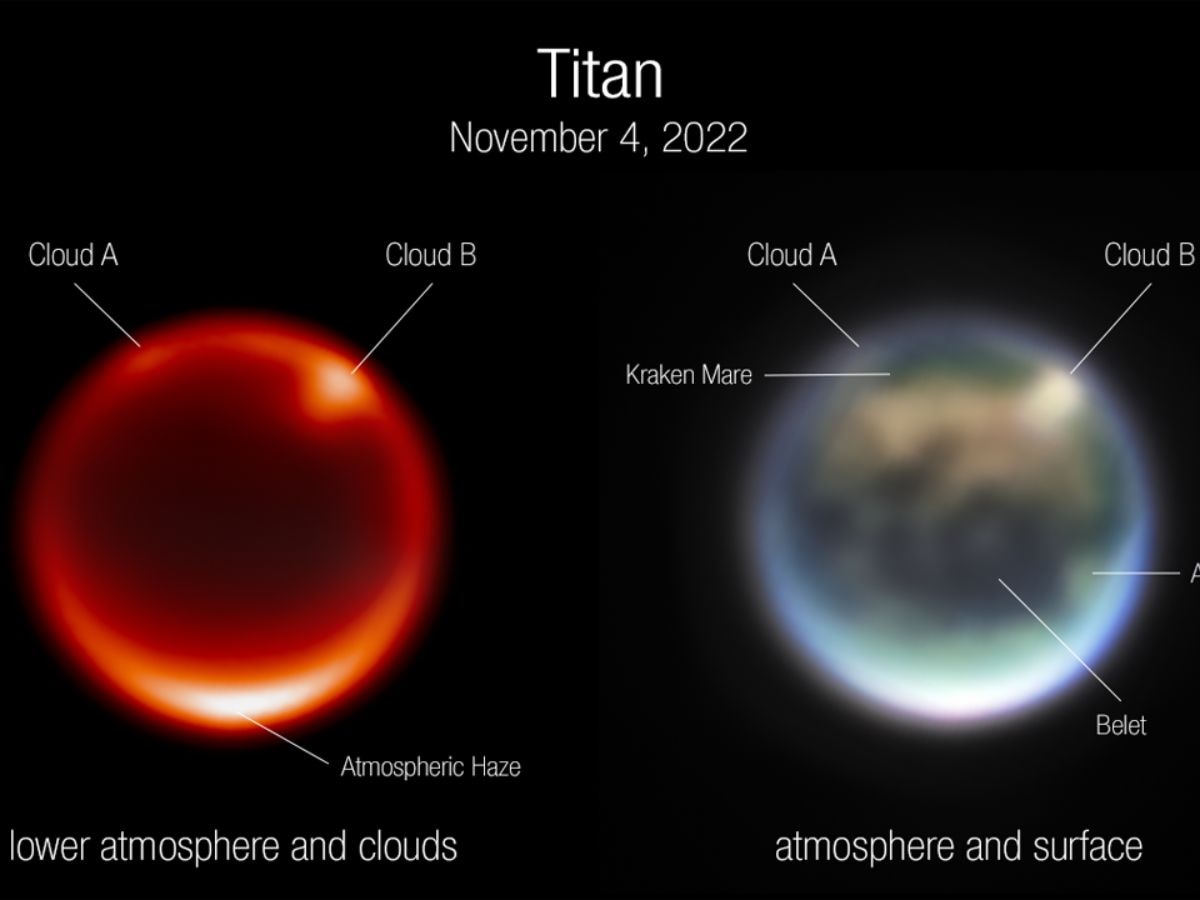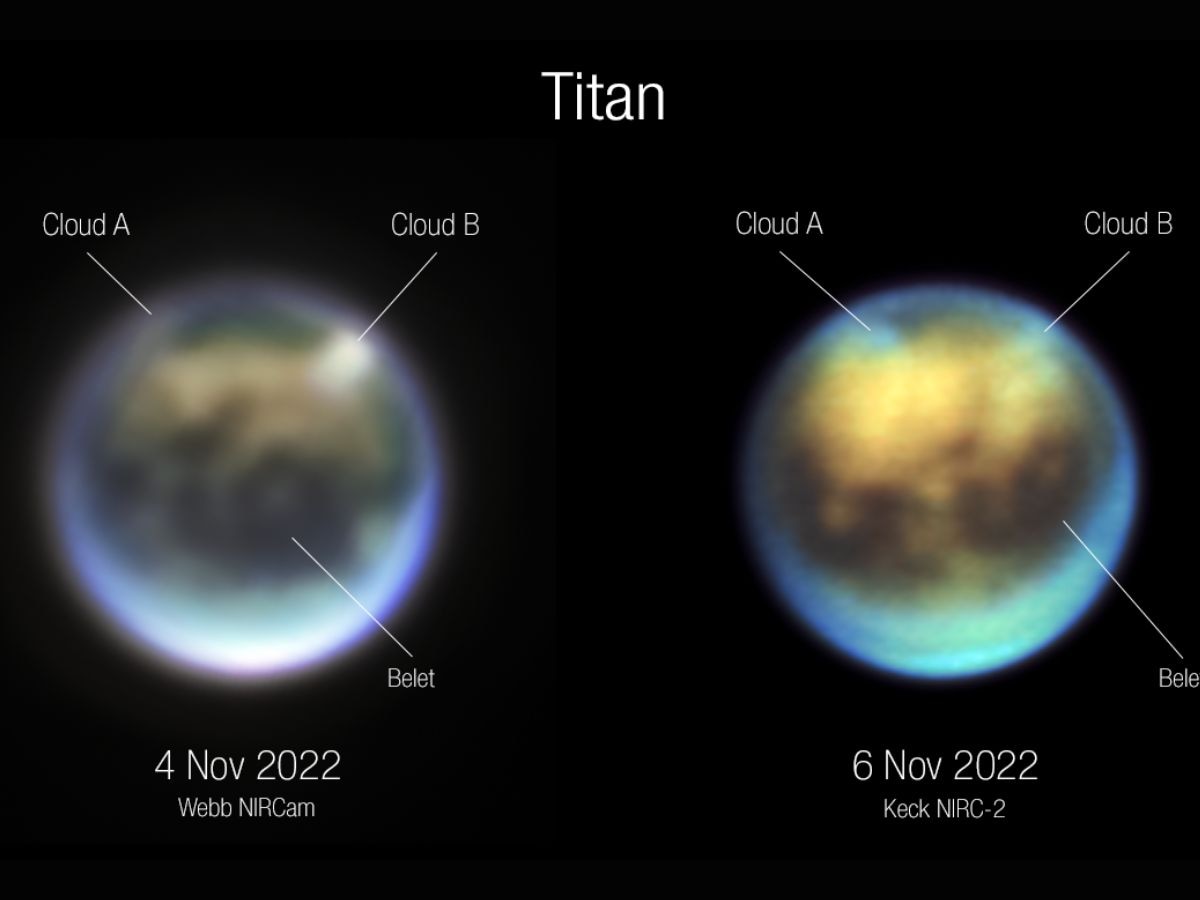James Webb Space Telescope Captures Its First Image Of Saturn's Largest Moon Titan: All About It
The only moon in the solar system with a dense atmosphere, Titan is also the only planetary body other than Earth that currently has rivers, lakes and seas.

NASA's James Webb Space Telescope has captured its first images of Saturn's largest moon, Titan. While the pictures were captured in November, NASA unveiled them in December. Margaret W Carruthers from the Space Telescope Science Institute said in a NASA statement that a team of researchers used Webb's infrared vision to study Titan's atmosphere, including its fascinating weather patterns and gaseous composition. Webb has enabled the team to see through the haze to study bright and dark patches on the surface of Titan.
Carruthers said Titan's atmosphere is incredibly interesting, not only due to its methane clouds and storms, but also because of what it can tell astronomers about Titan's past and future. The current atmosphere can also tell researchers whether Titan always had an atmosphere.
More about Titan
The only moon in the solar system with a dense atmosphere, Titan is also the only planetary body other than Earth that currently has rivers, lakes and seas. However, the liquid on Titan's surface, unlike Earth, is composed of hydrocarbons including methane and ethane, not water. Also, Titan's atmosphere is filled with thick haze that obscures visible light reflecting off the surface.
Two clouds found above Titan
Carruthers said the team compared different images captured by Webb's Near-Infrared Camera (NIRCam), and confirmed that a bright spot visible in Titan's northern hemisphere was in fact a large cloud. The researchers also noticed a second cloud.
Scientists have made several predictions about Titan's climate using computer models. They also predicted that clouds would form readily in the mid-northern hemisphere during its late summertime when the surface is warmed by the Sun. According to Carruthers, detecting clouds is exciting because it validates the predictions about Titan's climate made by computer models.
What Webb’s images of Titan mean
NASA has shared two images of Titan captured by Webb. The image seen on the left has been captured using F212N, a 2.12-micron filter sensitive to Titan's lower atmosphere. The bright spots seen on the moon are prominent clouds in the northern hemisphere.

The image on the right is a colour-composite image captured using a combination of NIRCam filters. Some of the prominent surface features labelled on the image are Kraken Mare, Belet and Adiri. Kraken Mare is thought to be a methane sea, Adiri is a bright albedo feature (fraction of light reflected by a body), and Belet is composed of dark-coloured sand dunes.
Follow-up observations using Keck
Carruthers added that the team then realised it was important to find out if the clouds were moving or changing shape. This data might reveal information about the air flow in Titan's atmosphere. Therefore, the researchers reached out to colleagues to request follow-up observations using the Keck Observatory in Hawai'i.
The large cloud appeared to be over the northern polar region near Kraken Mare. Researchers from University of California, Berkeley and Caltech queued up a set of observations using the Keck Observatory to probe Titan from its stratosphere to surface.
In the NASA statement, Imke de Pater from University of California, Berkeley, said when the researchers looked at the clouds on Titan on November 4 and 6, they found the clouds to be at the same positions, looking like they had changed in shape.
The follow-up observations made using Keck Observatory confirmed seasonal weather patterns on Titan.
More about Titan’s clouds
The researchers named the two clouds observed on Titan Cloud A and Cloud B. According to NASA, Cloud A appeared to be rotating into view while Cloud B appeared to be either dissipating or moving behind Titan's limb, which refers to the hemisphere facing away from Earth.

The team of researchers are now analysing the spectra collected using Webb's Near-Infrared Spectrograph (NIRSpec) to probe the composition of Titan's lower atmosphere and surface, and learn more about what is causing the bright feature seen over the south pole.
Related Video
Southern Rising Summit 2024: How Important is Self-Awareness? Insights from Anu Aacharya | ABP LIVE






































